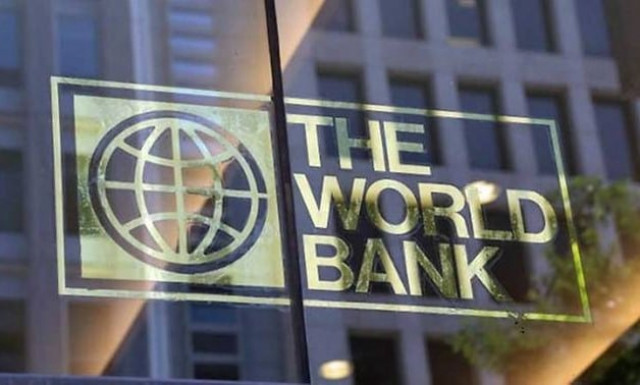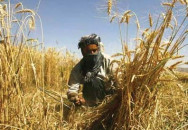Pakistan’s GDP growth may slow down to 3.4%: World Bank
The projections that WB has made in its report are more alarming than the estimates of the Asian Development Bank

The logo of the World Bank. PHOTO: AFP
The projected levels of the budget deficit - gap between expenditures and revenues – and public debt to Gross Domestic Product ratio for the fiscal year 2018-19 are higher than the levels of the last year of Pakistan Muslim League-Nawaz (PML-N) government.
The report also underlined that the risk for sovereign debt default by Pakistan has again increased from last month.
The projections that the WB has made in its report 'South Asia Economic Focus - Exports Wanted', released on Sunday, are more alarming than the estimates of the Asian Development Bank.
The report also predicted an economic growth rate of just 3.4pc for the current fiscal year - the lowest in eight years. Also, it has claimed that the average inflation in this fiscal year would jump to 7.1pc and will hit a dangerous level of 13.5pc in the next fiscal year due to further currency devaluation and hike in utility prices.
World Bank team to arrive in Pakistan to assess impact of reforms
"The pace of poverty reduction is expected to continue to slowdown in the current as well as in the next fiscal year, following the projected growth deceleration and higher inflation rates."
According to independent economists, 13.5pc inflation would mean that the State Bank which has committed to keep real interest rates positive will have to raise the policy rate to over 15pc.
Yet the Washington-based lending agency has advocated further currency devaluation, hike in interest rates and fiscal tightening - the recipes that will strangle economic growth and increase poverty levels. It added that the higher inflation rates may jeopardize recent gains in poverty reduction, since poor households in urban areas are particularly affected by increase in prices.
If one goes by the projections made by the WB, the government of Prime Minister Imran Khan cannot end the miseries of the nation. There will be more debt even in terms of size of the economy, more inflation, more unemployment and more poverty in the country as compared to the PML-N government.
"The current macroeconomic challenges in Pakistan are primarily the result of past policy choices," said the WB, throwing the responsibility on the last PML-N government.
Pakistan, IMF at odds over Rs5.4tr tax collection target
The report noted that Pakistan has made some adjustments over the past year. "However, further adjustments will be needed".
Public Debt
The debt to GDP ratio would jump to 82.3pc by the end of this fiscal year as against 73.5pc left behind by the PML-N government, according to the report. In 2001-2, the debt to GDP ratio had been recorded at 81.8pc. But Pakistan managed to win some debt relief from the western countries that helped it lower the dangerous debt levels.
The WB said that from fiscal year 2019-20, the debt level may start going down, albeit gradually. But by the end of the third year of the PTI tenure, it will be still at 75.4pc of the GDP. The elevated debt levels have increased "Pakistan's exposure to debt-related shocks," said the WB.
The low foreign currency reserves position and high debt ratios limit the buffers that Pakistan could use to absorb external shocks such as an increase in US interest rates and may negatively impact the government's ability to access international markets, said the WB.
For developing countries like Pakistan, 50pc debt to GDP ratio is considered sustainable. The servicing of growing public debt is the single largest expense of the budget, consuming nearly 36pc.
Budget Deficit
The WB has projected that the budget deficit would widen to 6.9pc of the GDP, which will be equal to Rs2.63 trillion, in the current fiscal year. During the last fiscal year, the budget deficit was 6.5pc of the GDP. The WB said that the budget deficit would still remain higher during next two years as well, standing at 5.3pc of the GDP by the end of 2020-21.
GDP growth
It said that Pakistan's GDP growth is projected to slow down to 3.4pc in fiscal year 2018-19, "from 5.8pc a year before," reflecting a broad-based weakening in domestic demand as monetary and fiscal policies have been tightened to contain macroeconomic imbalances. It seems that WB has not accepted the PTI government's decision to downward revise the last year's economic growth rate to 5.2pc.
The GDP growth is expected to further slow to 2.7pc in fiscal year 2019-20, as domestic demand remains depressed. Macroeconomic imbalances, reflected in large fiscal and current account deficits are expected to resolve gradually. It said that a relatively more stable external environment is seen to help a pickup in economic activity starting from fiscal year 2020-21 - the third year of the PTI. But still it will only be 4pc, it added.
Inflation
The report has projected that average inflation is expected to rise to 7.1pc during the current fiscal year and will reach 13.5pc in fiscal year 2019-20 as a result of further exchange rate depreciation and follow up increase in prices of almost all commodieties.
The WB underlined that economic uncertainty in Pakistan has increased due to protracted negotiations with the IMF. In addition, recent regional tensions had an impact on risk perceptions.
It said that to put the country on a path of stable growth, Pakistan has to increase its exchange rate flexibility, improve competitiveness and lower cost of doing business. On the revenue front, reforms to improve tax administration, widen tax base and facilitate tax compliance are critical.
"The new government took steps to address these imbalances, but outcomes by mid-year suggest that further adjustments will be necessary," said the WB.
Default Threat
Sovereign credit default swap spreads increased in the second half of last year in India, Pakistan, and Sri Lanka but declined at the beginning of this year. These credit default swaps are an insurance against the debt default of the country and the price, hence, reflects the market expectations of such a default. From May 2018 to December 2018, they rose from 3.7pc to 4.6pc in Pakistan. But in March 2019, the sovereign credit default swap spread again spiked.



















COMMENTS
Comments are moderated and generally will be posted if they are on-topic and not abusive.
For more information, please see our Comments FAQ